It looks like you're using an Ad Blocker.
Please white-list or disable AboveTopSecret.com in your ad-blocking tool.
Thank you.
Some features of ATS will be disabled while you continue to use an ad-blocker.
21
share:
In this recent image post dated 10 December 2018 from HiRise. Mars spiders are imaged on CO2 ice. It states
When sun rays strike this surface, this carbon dioxide ice acts in a similar way to our atmosphere: it allows the sun light to penetrate but traps
the infrared radiation creating a greenhouse-like effect., but does not mention the optical properties of the ice or exactly what we are looking
at.
The Enduring Charm of Martian Spiders
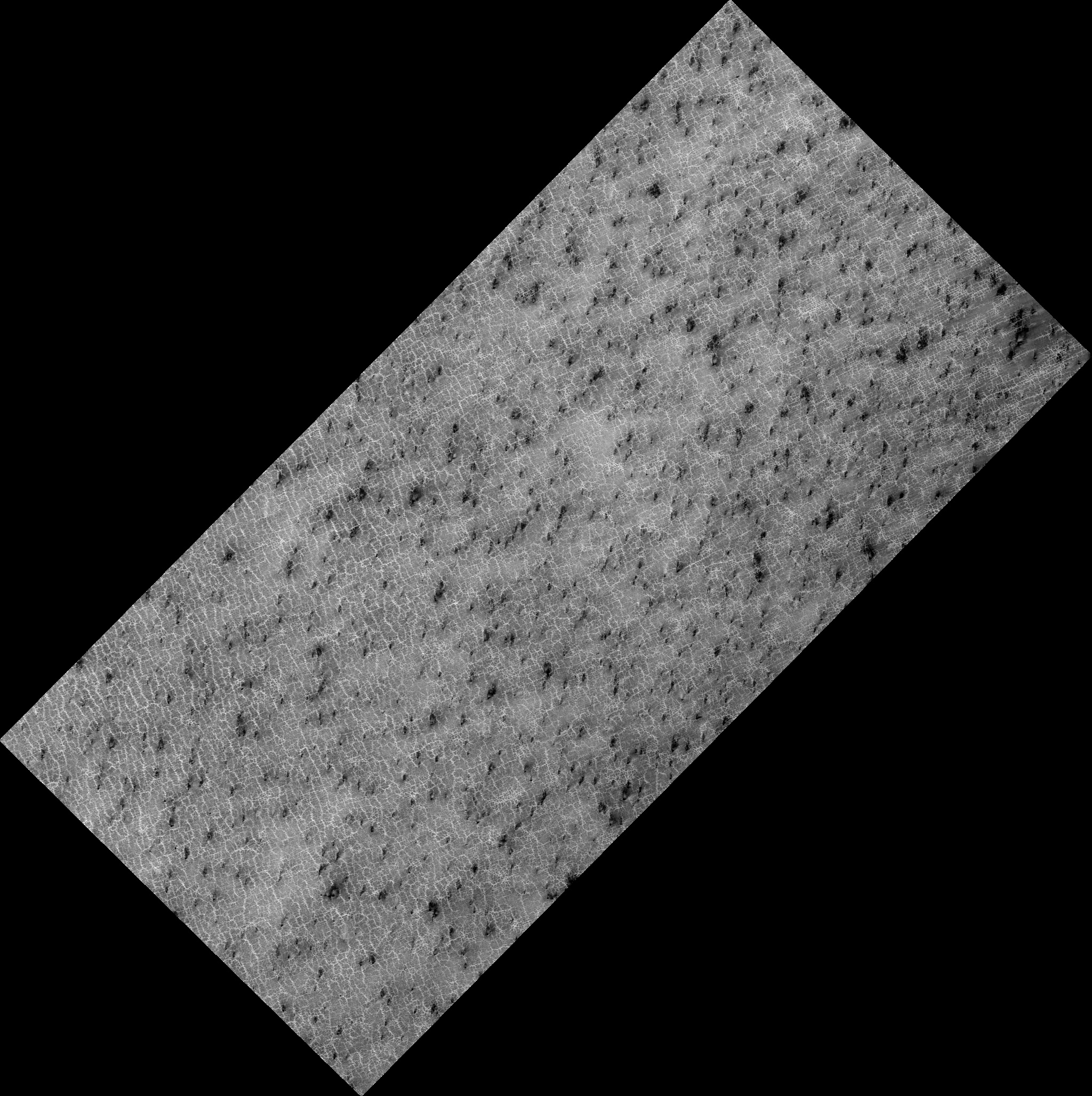
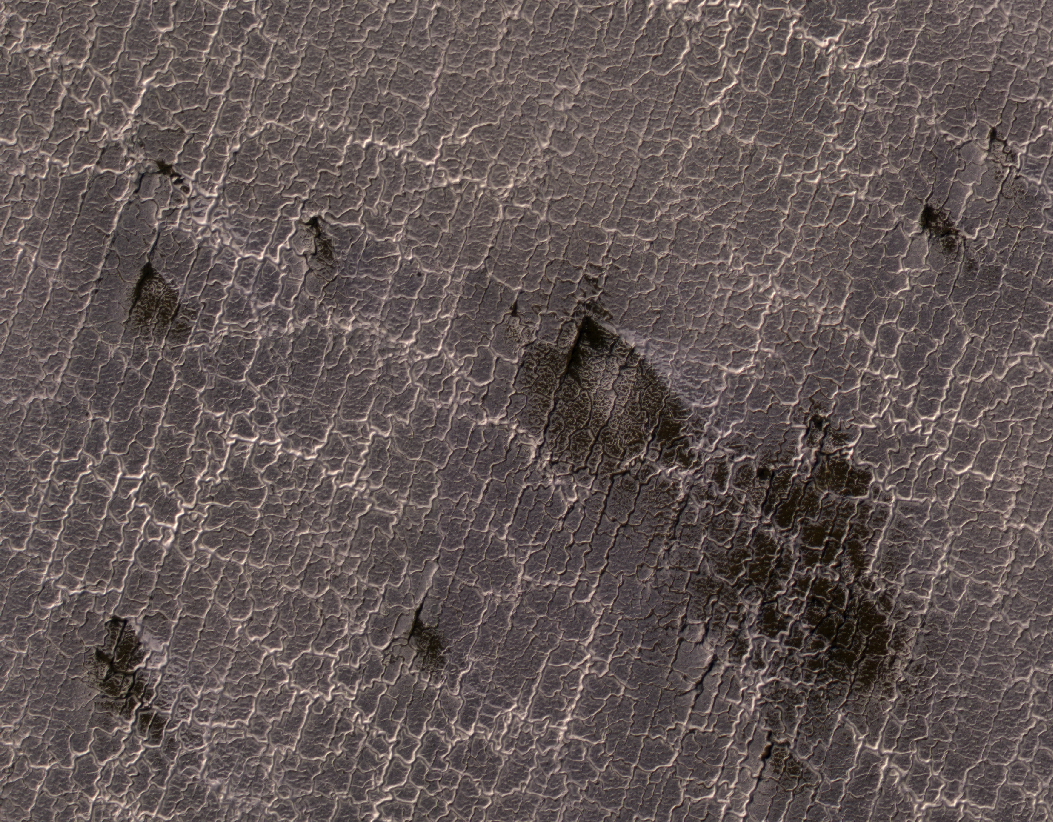

In this report from HiRise it does state the optical properties of the ice. when the sun begins to warm the surface below the translucent ice, but not exactly what we are looking at.
Fans on Ice
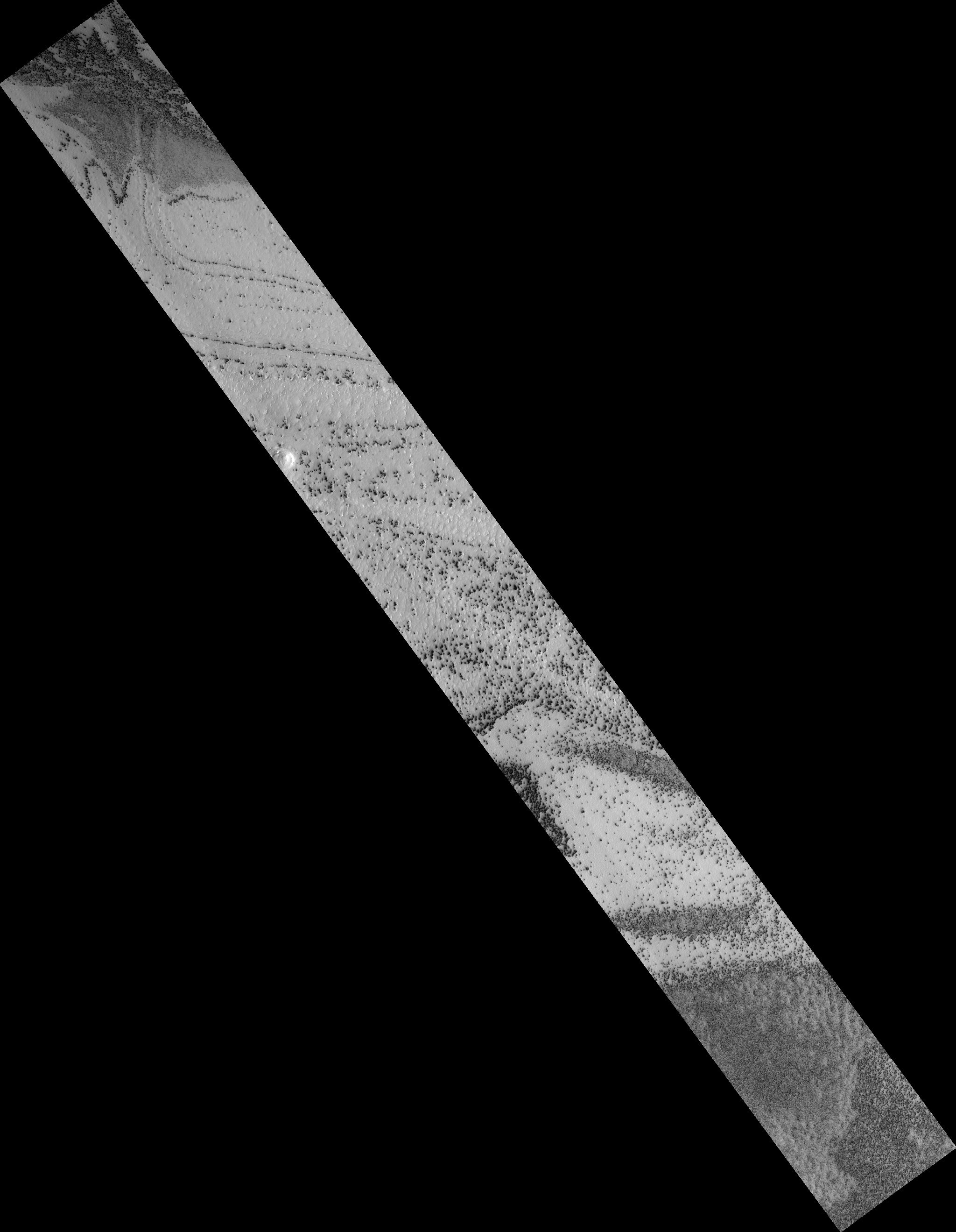
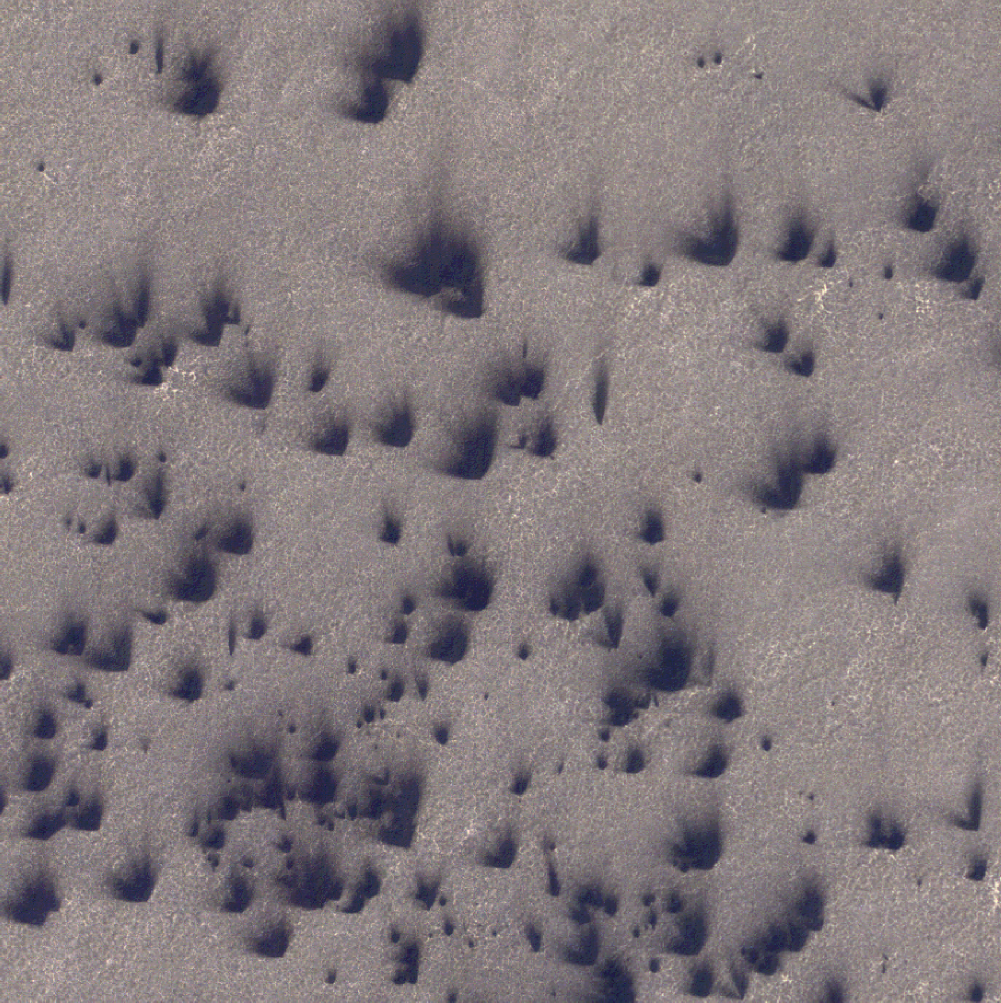
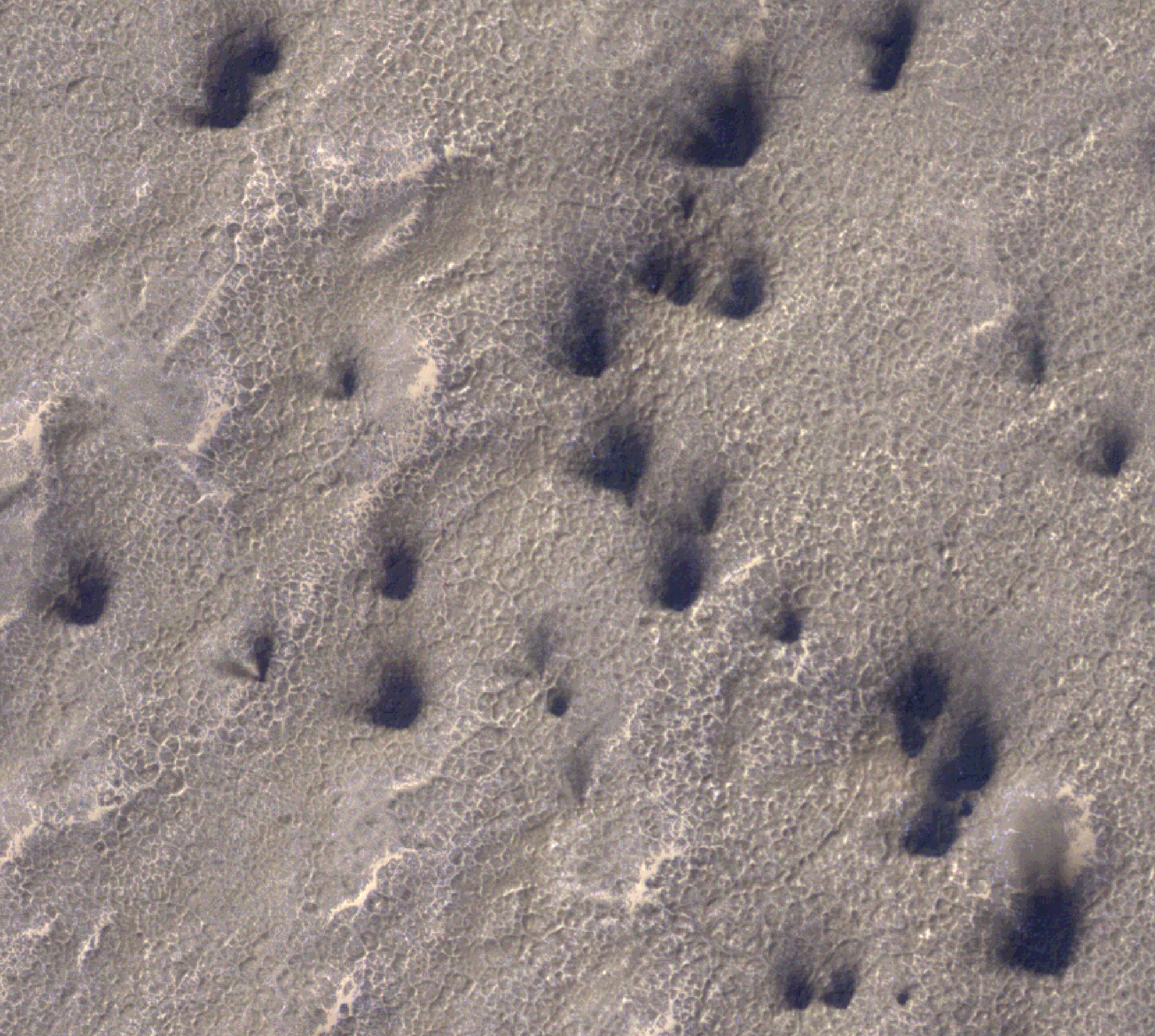
In this OP I did a while ago, I hinted at the ice being transparent and gas making tunnels in the ice as it escapes. I wanted to see if anyone else saw that and did not want to bias it by stating that. The image in the that OP, ESP_012506_0850 is the best one I have come across of the spiders on the ice of Mars.


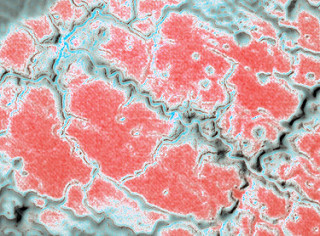
Do you think we are looking through transparent ice? Are these cracks, gullies, "river beds" or what? Is the gas just cracking the ice to make the fans on the surface? There are more and larger images in the OP linked above if interested.
Araneiform terrain (colloquially: spider-like terrain) is located in the south polar region of Mars and evolves in appearance over the spring and summer. In the season shown here, the thin bright lines on the surface (the spider legs) are troughs and many of these features have dark fan-shaped markings emanating from them. Our current theory for how these patterns are formed is that during winter a carbon dioxide ice layer develops over the surface. When sun rays strike this surface, this carbon dioxide ice acts in a similar way to our atmosphere: it allows the sun light to penetrate but traps the infrared radiation creating a greenhouse-like effect. The trapped heat transforms the ice at the bottom of the layer to gas, building up pressure until it bursts through. When that happens, the gas flows out in geyser-like fashion and carries dust with it, which falls back to the surface to form the dark fans. Written by: M. Ramy El-Maarry (10 December 2018)
The Enduring Charm of Martian Spiders



In this report from HiRise it does state the optical properties of the ice. when the sun begins to warm the surface below the translucent ice, but not exactly what we are looking at.
Every southern winter the south polar region of Mars is covered with an approximately 1 meter deep layer of frozen carbon dioxide (dry ice). In the spring, when the sun begins to warm the surface below the translucent ice, gas flow under the ice carries loose dust from the surface up onto the top. The dust falls to the surface in fans, whose orientation is determined by the direction of the local wind flow. Fans from one source region pointing in multiple directions show how the wind direction has changed. Narrow fans pointing in just one direction are the most recent. Alternatively, the vent from the surface may have re-annealed, such that these fans were formed over a very limited time span. Written by: Candy Hansen (18 February 2009)
Fans on Ice



In this OP I did a while ago, I hinted at the ice being transparent and gas making tunnels in the ice as it escapes. I wanted to see if anyone else saw that and did not want to bias it by stating that. The image in the that OP, ESP_012506_0850 is the best one I have come across of the spiders on the ice of Mars.



Do you think we are looking through transparent ice? Are these cracks, gullies, "river beds" or what? Is the gas just cracking the ice to make the fans on the surface? There are more and larger images in the OP linked above if interested.
So you telling me, that you can see tunnels in one meter of dry ice?
These are definitely gas holes or something, but I'm not convinced that the tunneling exists only at the top layer of dry ice. There must be semi-permanent fixture for this. So there is some gas and dust distribution system that exists independently of the ice tunnels.
These are definitely gas holes or something, but I'm not convinced that the tunneling exists only at the top layer of dry ice. There must be semi-permanent fixture for this. So there is some gas and dust distribution system that exists independently of the ice tunnels.
a reply to: Archivalist
I am not sure if it is tunnels or channels made by something flowing over the ice or both. That is my best guess, but not really sure what it is.
I am not sure if it is tunnels or channels made by something flowing over the ice or both. That is my best guess, but not really sure what it is.
Well, I don't know much - anything really about this stuff, so if you will, please excuse my ignorance.
originally posted by: LookingAtMars
a reply to: Archivalist
I am not sure if it is tunnels or channels made by something flowing over the ice or both. That is my best guess, but not really sure what it is.
But, couldn't there be multiple theories, those 'spiders', which to me look like cracks on a windscreen, could not be formed by small meteor impacts?
I don't suppose anyone knows, but somehow I have the hunch that you've thought through what you think it is, so i'm sure there are good reasons there.
a reply to: Assemble
If it is cracks, it is more likely from the pressure of the CO2 that has been heated up under the ice. Most of them look too curvy to be cracks though. In this image you can see cracks and something else.
Cracks also happen from changes in temperature and other related things like expansion of the ground. The cracks are most likely in the ground under the ice and not in the ice itself. I believe that is the Polygonal Ground the title is referring to. Defrosting Spots Over Polygonal Ground
If it is cracks, it is more likely from the pressure of the CO2 that has been heated up under the ice. Most of them look too curvy to be cracks though. In this image you can see cracks and something else.
Cracks also happen from changes in temperature and other related things like expansion of the ground. The cracks are most likely in the ground under the ice and not in the ice itself. I believe that is the Polygonal Ground the title is referring to. Defrosting Spots Over Polygonal Ground
edit on 26-12-2018 by LookingAtMars because: Fix, change and add links
These are troughs / channels on the surface, from what I can see (and from what the articles say). I also think they're too smooth and sinuous to be
cracks.


There might be a possibility that the pattern of those channels corresponds to the terrain below. Ice-free terrain in the polar regions shows a lot of rectangular and polygonal features.
There are some articles describing the dark fans and blotches created by CO2 jets, but I can't see anything about those chnnels.
This article describes the dark cracks found in semi-translucent CO2 ice.
Martian spiders come in many shapes, here's a very different-looking bunch of them: www.uahirise.org...


There might be a possibility that the pattern of those channels corresponds to the terrain below. Ice-free terrain in the polar regions shows a lot of rectangular and polygonal features.
There are some articles describing the dark fans and blotches created by CO2 jets, but I can't see anything about those chnnels.
This article describes the dark cracks found in semi-translucent CO2 ice.
Martian spiders come in many shapes, here's a very different-looking bunch of them: www.uahirise.org...
edit on 27-12-2018
by wildespace because: (no reason given)
a reply to: wildespace
Cool, thanks for the links. So do you think the top layer is Martian soil or ice? Are we seeing the red surface through transparent ice? The HiRise reports talks about the Sun warming the surface below the ice.
Is the surface the above quote talks about below transparent ice?
What part of the image is the above quote talking about? From what I can tell most of the image is this translucent ice.
I really would like to know where you and others think the ice is HiRise is talking about in these images. Since the reports do not make that clear.
Cool, thanks for the links. So do you think the top layer is Martian soil or ice? Are we seeing the red surface through transparent ice? The HiRise reports talks about the Sun warming the surface below the ice.
When sun rays strike this surface, this carbon dioxide ice acts in a similar way to our atmosphere: it allows the sun light to penetrate but traps the infrared radiation creating a greenhouse-like effect.
Is the surface the above quote talks about below transparent ice?
when the sun begins to warm the surface below the translucent ice, gas flow under the ice carries loose dust from the surface up onto the top
What part of the image is the above quote talking about? From what I can tell most of the image is this translucent ice.
I really would like to know where you and others think the ice is HiRise is talking about in these images. Since the reports do not make that clear.
originally posted by: LookingAtMars
a reply to: wildespace
Cool, thanks for the links. So do you think the top layer is Martian soil or ice? Are we seeing the red surface through transparent ice? The HiRise reports talks about the Sun warming the surface below the ice.
When sun rays strike this surface, this carbon dioxide ice acts in a similar way to our atmosphere: it allows the sun light to penetrate but traps the infrared radiation creating a greenhouse-like effect.
Is the surface the above quote talks about below transparent ice?
when the sun begins to warm the surface below the translucent ice, gas flow under the ice carries loose dust from the surface up onto the top
What part of the image is the above quote talking about? From what I can tell most of the image is this translucent ice.
I really would like to know where you and others think the ice is HiRise is talking about in these images. Since the reports do not make that clear.
The ice is everywhere on the surface in these images (martian soil never looks that grey), and the dust ejected by CO2 jets is what creates the dark fans.
The ice seems to be semi-transparent, as we can't see the solid surface below it.
This image shows clear distinction between ice and soil:

Spiders on mars ?.... , rick rolled again . beh If Nasa wants attention why don't they put transgenders on the moon.
I would not rule out an electric phenomenon as the creator of those patterns.
It reminded me a little of the Lichtenberg figures.

It reminded me a little of the Lichtenberg figures.

a reply to: EartOccupant
Good point, the Electric Universe theory never came to mind when I was looking at this.
Good point, the Electric Universe theory never came to mind when I was looking at this.
After reading the links from wildespace and looking at the pics for a while I believe "The Enduring Charm of Martian Spiders" image is showing a
surface of cracked translucent ice. The ice must sublime away in a way that it leaves the curvy channels.
Everything about Mars is hard, ever seeing the images right. You have to look at the image and see it the right way. You can see the feature as hills, tubes or channels.
After finding out what direction the sunlight is coming from I am now sure these are channels in the image. It seems the channels were cracks and when the ice at the cracks sublimed away it left the curvy channels. I am not sure why though.
It may be easier to see in this crop.
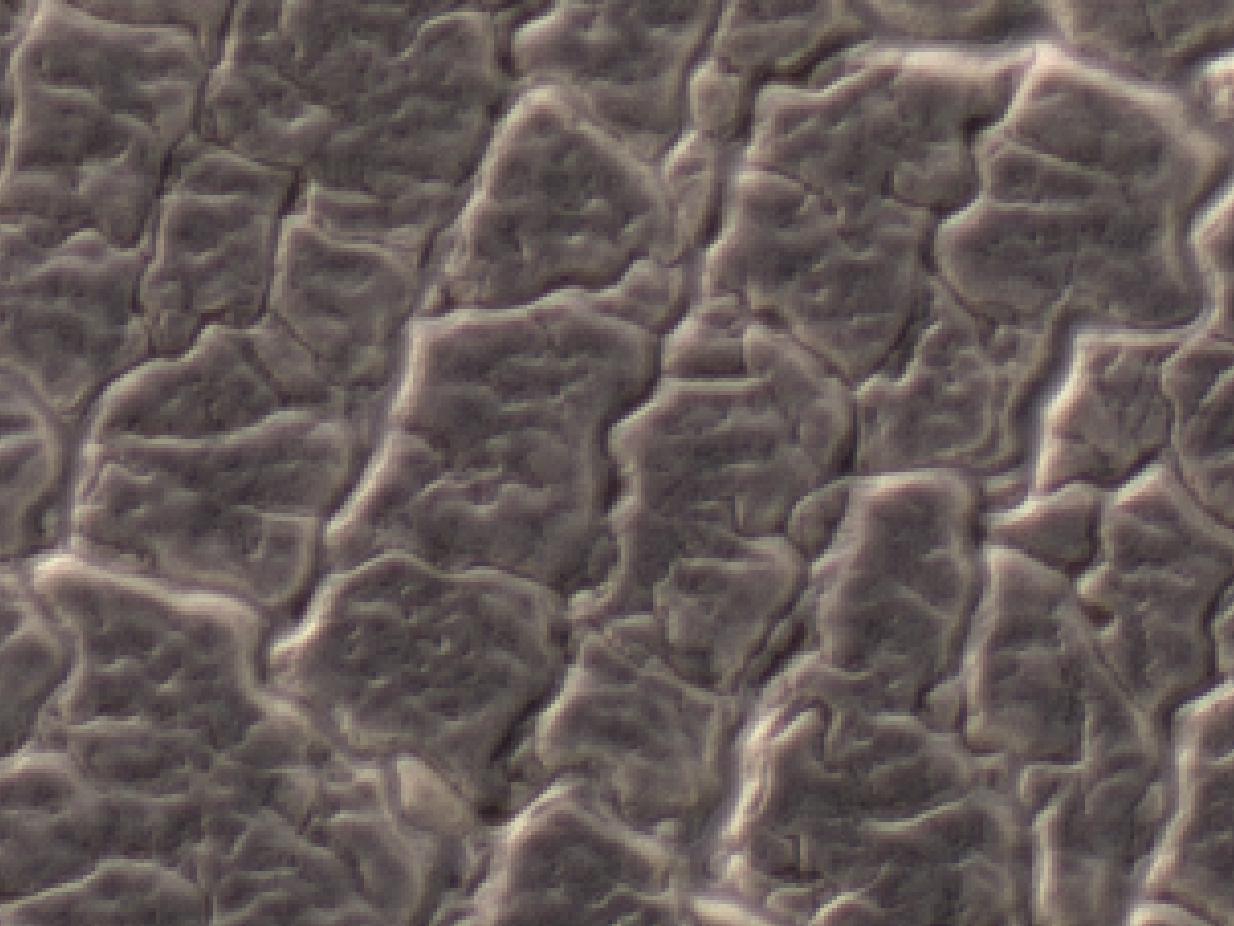
Now look at the images below and see the ice the way it looks in the above crop. There is some kind of process that makes the cracks and turns them into curvy channels. This is what I think anyway, who knows whats really going on it is on Mars.

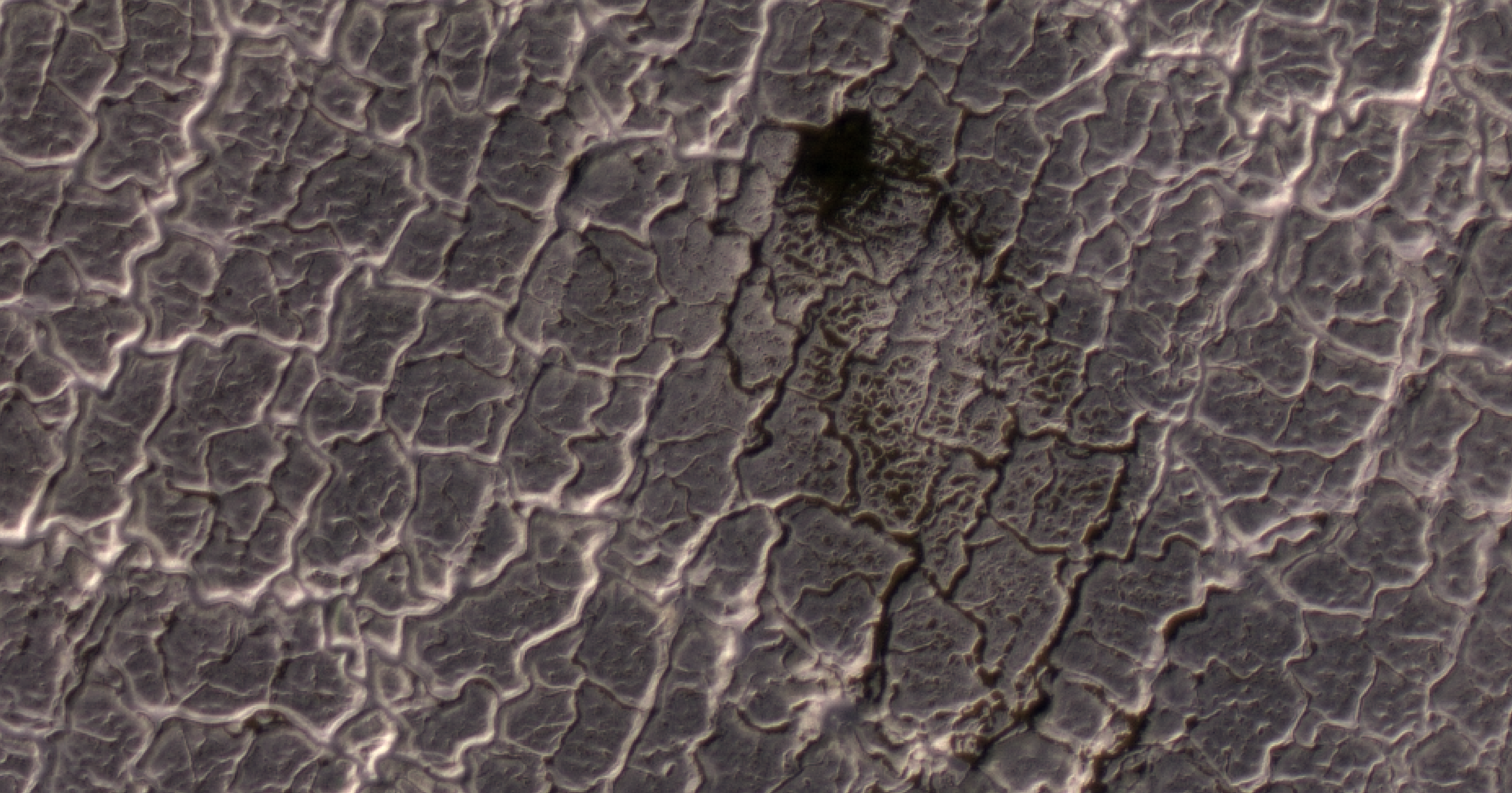
Then there is this image Defrosting Spots Over Polygonal Ground. It has features like in the above images but there is not any translucent ice in the image.

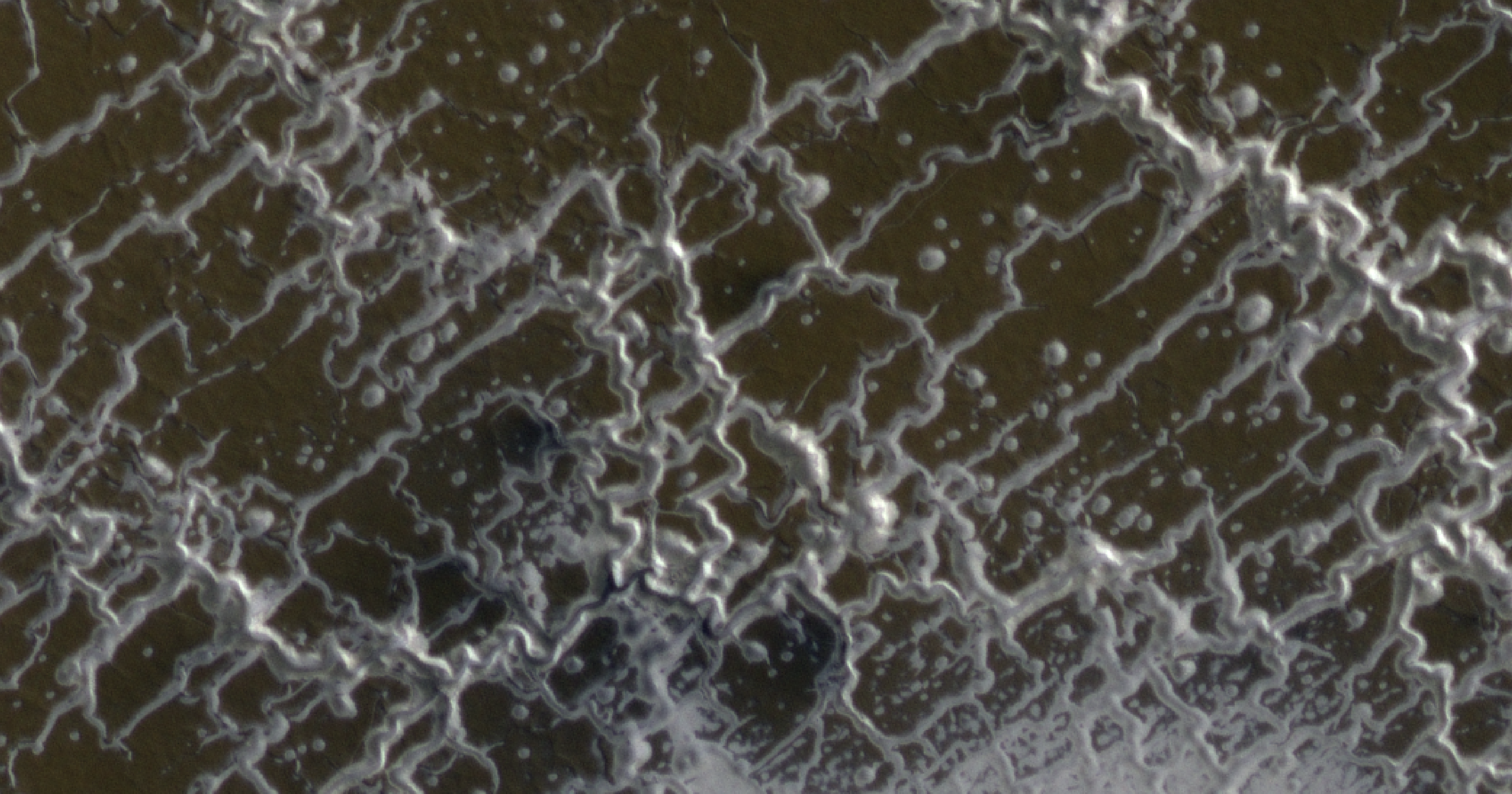
It seems it shows transparent C02 ice or maybe red C02 ice. There must be ice there because of the curvy channels that are similar to the one in the above image.
It is difficult for me to see this image the right way and see the features as channels and not tubes or hills but I believe they are curvy channels just like in the above images. Anyway that's my 2 cents worth
Everything about Mars is hard, ever seeing the images right. You have to look at the image and see it the right way. You can see the feature as hills, tubes or channels.
After finding out what direction the sunlight is coming from I am now sure these are channels in the image. It seems the channels were cracks and when the ice at the cracks sublimed away it left the curvy channels. I am not sure why though.
It may be easier to see in this crop.

Now look at the images below and see the ice the way it looks in the above crop. There is some kind of process that makes the cracks and turns them into curvy channels. This is what I think anyway, who knows whats really going on it is on Mars.


Then there is this image Defrosting Spots Over Polygonal Ground. It has features like in the above images but there is not any translucent ice in the image.


It seems it shows transparent C02 ice or maybe red C02 ice. There must be ice there because of the curvy channels that are similar to the one in the above image.
It is difficult for me to see this image the right way and see the features as channels and not tubes or hills but I believe they are curvy channels just like in the above images. Anyway that's my 2 cents worth
originally posted by: LookingAtMars
Defrosting Spots Over Polygonal Ground. It has features like in the above images but there is not any translucent ice in the image.
It seems it shows transparent C02 ice or maybe red C02 ice. There must be ice there because of the curvy channels that are similar to the one in the above image.
It is difficult for me to see this image the right way and see the features as channels and not tubes or hills but I believe they are curvy channels just like in the above images. Anyway that's my 2 cents worth
Here, I see dust-covered ice (the dark reddish stuff is on the surface), with icy cracks/channels exposed by sublimation.
I agree that it all seems unfamiliar to what you're used to seeing on earth.
You could compare these scenes on Mars with those on Pluto, where there are complex patterns, pits, and dunes in the nitrogen ice fields.
originally posted by: EartOccupant
I would not rule out an electric phenomenon as the creator of those patterns.
It reminded me a little of the Lichtenberg figures.
Just because things in the lab look very similar to things in nature, doesn't mean they're caused by the same phenomenon.
Saying that, it would be cool to see a lab experiment where CO2 ice lying over a bedrock and in a Mars-like environment gets slowly eroded by sublimation when light and heat are applied. Perhaps that's just how sublimation works in these conditions.
new topics
-
America's Greatest Ally
General Chit Chat: 23 minutes ago -
President BIDEN's FBI Raided Donald Trump's Florida Home for OBAMA-NORTH KOREA Documents.
Political Conspiracies: 5 hours ago -
Maestro Benedetto
Literature: 6 hours ago -
Is AI Better Than the Hollywood Elite?
Movies: 7 hours ago -
Las Vegas UFO Spotting Teen Traumatized by Demon Creature in Backyard
Aliens and UFOs: 10 hours ago -
2024 Pigeon Forge Rod Run - On the Strip (Video made for you)
Automotive Discussion: 11 hours ago -
Gaza Terrorists Attack US Humanitarian Pier During Construction
Middle East Issues: 11 hours ago
top topics
-
President BIDEN's FBI Raided Donald Trump's Florida Home for OBAMA-NORTH KOREA Documents.
Political Conspiracies: 5 hours ago, 26 flags -
Krystalnacht on today's most elite Universities?
Social Issues and Civil Unrest: 16 hours ago, 9 flags -
Gaza Terrorists Attack US Humanitarian Pier During Construction
Middle East Issues: 11 hours ago, 8 flags -
Supreme Court Oral Arguments 4.25.2024 - Are PRESIDENTS IMMUNE From Later Being Prosecuted.
Above Politics: 16 hours ago, 8 flags -
Weinstein's conviction overturned
Mainstream News: 15 hours ago, 8 flags -
Massachusetts Drag Queen Leads Young Kids in Free Palestine Chant
Social Issues and Civil Unrest: 13 hours ago, 7 flags -
Las Vegas UFO Spotting Teen Traumatized by Demon Creature in Backyard
Aliens and UFOs: 10 hours ago, 6 flags -
Meadows, Giuliani Among 11 Indicted in Arizona in Latest 2020 Election Subversion Case
Mainstream News: 13 hours ago, 5 flags -
2024 Pigeon Forge Rod Run - On the Strip (Video made for you)
Automotive Discussion: 11 hours ago, 4 flags -
Is AI Better Than the Hollywood Elite?
Movies: 7 hours ago, 3 flags
active topics
-
Is AI Better Than the Hollywood Elite?
Movies • 16 • : 5thHead -
Hate makes for strange bedfellows
US Political Madness • 48 • : Terpene -
America's Greatest Ally
General Chit Chat • 0 • : 19Bones79 -
President BIDEN's FBI Raided Donald Trump's Florida Home for OBAMA-NORTH KOREA Documents.
Political Conspiracies • 17 • : BingoMcGoof -
Gaza Terrorists Attack US Humanitarian Pier During Construction
Middle East Issues • 29 • : 19Bones79 -
Supreme Court Oral Arguments 4.25.2024 - Are PRESIDENTS IMMUNE From Later Being Prosecuted.
Above Politics • 90 • : Lumenari -
Las Vegas UFO Spotting Teen Traumatized by Demon Creature in Backyard
Aliens and UFOs • 12 • : KrustyKrab -
SHORT STORY WRITERS CONTEST -- April 2024 -- TIME -- TIME2024
Short Stories • 23 • : DontTreadOnMe -
Truth Social goes public, be careful not to lose your money
Mainstream News • 130 • : Astyanax -
-@TH3WH17ERABB17- -Q- ---TIME TO SHOW THE WORLD--- -Part- --44--
Dissecting Disinformation • 689 • : daskakik
21
